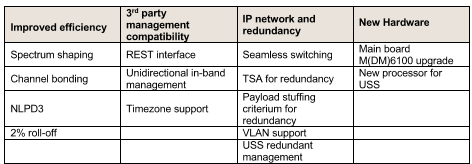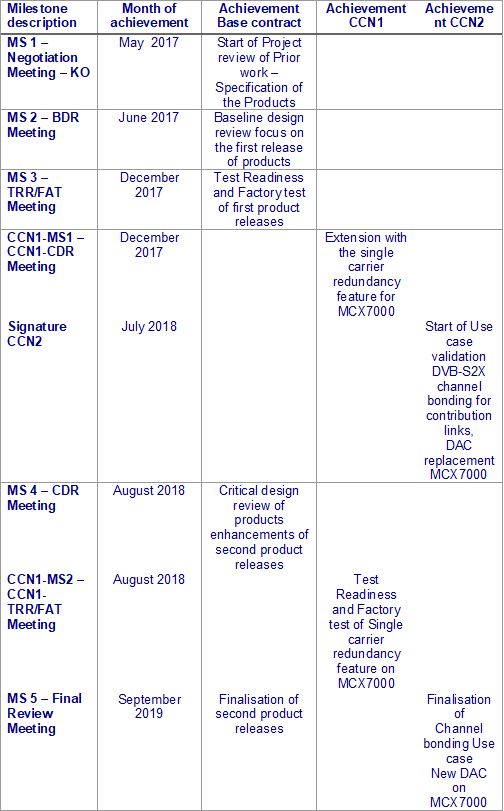
-
StatusCompleted
-
Status date2019-10-16
-
Activity Code7A.049
The Calvera project contains product development on the MDM6100 Broadcast Satellite Modem, on the MCX7000 Multi-Carrier Satellite Gateway and on the USS0202 Universal Redundancy Switch.
Project objectives are
- Improved performance, bringing higher bandwidth efficiency.
- Extended feature set for compatibility with customer’s management systems.
- Extended feature set for use in IP networks, including redundancy support.
- Keeping the hardware in good shape.

A real life over satellite use case on satellite bonding has been added to the project objectives.
The new features require software developments on existing platforms, except for the introduction of a new ‘monitor and control’ board for the redundancy switches and a hardware upgrade for replacement of an obsolete DAC.
The aim is to
- improve performance, bringing higher bandwidth efficiency
Higher bandwidth efficiency is an important factor in any business case as it brings lower OPEX; Equalink 3 predistortion, tight spectrum shaping and channel bonding make a difference.
- extend the feature set for compatibility with customer’s management systems
Customers want to spend as little as possible time and energy in integrating third party equipment in their systems. The availability of unidirectional in-band management is a must for the DTT receive equipment in the towers.
- extend the feature set for use in IP networks, including redundancy support
The switch from ASI to IP is taken up in most systems now all over the world. This implies that the modulators should be compatible with all types of IP network configurations, e.g. including VLANs. On top of this, redundancy switching can be based upon a large number of input stream quality indicators.
- keep the hardware in good shape
USS02x2 products are based upon a 10-year old platform and the processor is becoming obsolete.
M(DM)6100 hardware, also needs an upgrade for an obsolete DAC component.
Features on MCX7000 R2.1 & R2.2:
- Seamless switching
- Spectrum shaping with improved steepness/ sideband suppression and 2% roll-off
- Channel bonding acc. the DVB-S2X standard
Features on M(DM)6100 R2.9:
- DiSEqC protocol for receiver band switching
- REST interface for demod support
Features on MCX7000 R2.4:
- Support for VLAN on inputs and outputs
- Timezone support
Features on MCX7000 R2.3:
- NLPD3 predistortion support on main board modulator
- Use of Transport Stream Analyzer (TSA) for redundancy support on input streams
- Extended criteria for alarm generation
- On two streams for support on one carrier
- Optimization for support on maximum 4 carriers
- Payload stuffing as criterion for Transport Stream input switching on modulator
Features on M(DM)6100 R2.10 & 2.11:
- Payload stuffing as criterion for Transport Stream input switching on modulator (R2.10)
- Spectrum shaping with improved steepness/ sideband suppression and 2% roll-off (R2.11)
- Main board hardware update (replacing obsolete DAC) (R2.11)
Features on USS0202/USS0212 R2.4/R3.4:
- Redundant management ports for USS management, device alarm monitoring and device in-sync management
- USS control board redesign, replacing outdated and obsolete processor (version R3)
The MCX7000 block diagram is shown here:

The main board provides processor and FPGA hardware and has one modulator on-board. Three optional slots can be populated with three add-on modulators. The main board FPGA interfaces with the add-on modulators via a packetized TS bus.
The project consisted of two major releases of the products. The following development schedule was executed:

The project is completed in September 2019.
The project objectives as presented above have been achieved and a successful introduction on the satcom broadcast market is ongoing in parallel.



